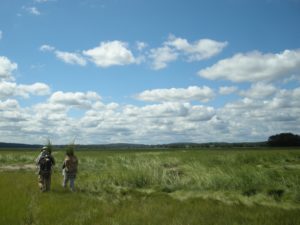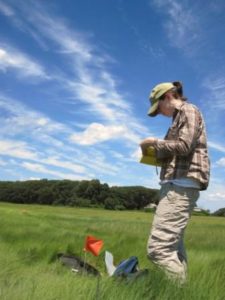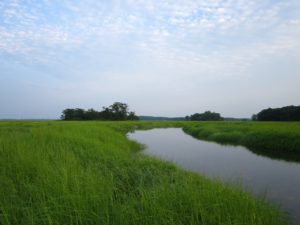 Introduction
Introduction
With ~75% of the worldwide human population living in coastal areas, coastal ecosystems are under tremendous influence from human activities. Two anthropogenic threats to coastal ecosystems are nutrient enrichment and altered food webs. Salt marshes, which occupy the land’s margins, are thought to be resilient to these perturbations. In the TIDE Project, we are testing the capacity of marshes to tolerate these threats in the marshes along the Rowley River in northeast Massachusetts.
A unique approach
The TIDE project is long-term experimental ecology at the scale of the ecosystem and unique in the world. We use an ecosystem-level approach to understand the effects of eutrophication and altered food webs on saltmarsh ecosystems in the Plum Island Estuary, Massachusetts. We are unique because we are the only experiment in the world to maintain a long-term (8 years as of 2011), landscape-level (6 ha per plot) fertilization manipulation. Fertilizer is added to the flooding waters of tidal creeks 15x reference levels to examine eutrophication effects on salt marshes. An additional manipulation is the removal of a key predator in this system, the killifish, Fundulus heteroclitus, to examine how food-web alterations impact trophic interactions and ecosystem functioning of the marsh. This manipulation, too, occurs at the landscape level. Our work has been funded by National Science Foundation. The TIDE Project operates within the larger Plum Island Ecosystem Long-Term Ecological Research program (PIE-LTER).
Addressing issues of global-change biology
Because the TIDE Project manipulations occur at such a large spatial and temporal scales, these manipulations influence multiple components within the ecosystem – similar to how real-world impacts influence ecosystems. We use an interdisciplinary approach and observe a range of responses – from bacteria to birds to biogeochemistry and geomorphology – for a more holistic understanding of salt marshes’ responses to perturbations. For instance, we are examining how changes in aboveground and belowground plant production affect the geomorphology of marshes, thus addressing how global changes in the nitrogen cycle influence the biological components of salt marshes which in turn can influence its abiotic systems.

An emphasis on undergraduate and young scientist involvement
As of 2011, over 100 scientists have researched on the TIDE project and at least 70 of those were young scientists – ranging from high-school interns to post-doctoral scientists. Young investigators are critical to the TIDE Project– often on the front lines of sampling and maintaining a large and challenging experiment. These young investigators have also contributed intellectually with many undergraduates and post-bachelor’s students as co-authors on TIDE-generated publications.
The TIDE Blog
The young scientists that are so critical to the TIDE Project are also responsible for the TIDE Blog. The blog posts are written by the young scientists of the project; those who are thigh-deep in the mud, swatting the flies, catching the fish, collecting the inverts, and sampling the mud. The fun parts of science! Please check out what these voices have to say from the field and learn about their science!
A Brief History of TIDE
- 2002: TIDE Experiment funded by the National Science Foundation
- 2003: TIDE Experiment begins with pre-treatment measurements
- 2004: Manipulations begin
- 2008: The 2nd iteration of the TIDE Project is funded by the National Science Foundation
- 2013: Our 10th year of nutrient enrichment began – Diamond Anniversary!
- 2016: Last year of fertilization, isotope addition experiment
- 2017: Salt marsh recovery phase begins
- 2019: The 3rd iteration of the TIDE Project is funded by the National Science Foundation to study recovery
 The TIDE Project will help us understand the long-term, cumulative effects of moderate increases in nutrients and changes in species on the productivity, food web, and physical structure of salt marshes. We use field measurements of changes in marsh processes to develop an ecosystem model that will predict the cumulative effects of nutrients and species changes on marshes over decades. Information on the effects of chronic, moderate levels of nutrients on coastal ecosystems is needed nationally and locally. Towns in New England are facing the same issues as thousands of other towns along the Atlantic seaboard. Because we do not know how salt marshes are affected by chronic nutrient loading and/or species composition changes, protecting or restoring these ecosystems for the long-term is difficult. The TIDE project will contribute needed information that will help to protect the existing healthy marshes, safeguard fisheries and biodiversity, and restore impacted marshes.
The TIDE Project will help us understand the long-term, cumulative effects of moderate increases in nutrients and changes in species on the productivity, food web, and physical structure of salt marshes. We use field measurements of changes in marsh processes to develop an ecosystem model that will predict the cumulative effects of nutrients and species changes on marshes over decades. Information on the effects of chronic, moderate levels of nutrients on coastal ecosystems is needed nationally and locally. Towns in New England are facing the same issues as thousands of other towns along the Atlantic seaboard. Because we do not know how salt marshes are affected by chronic nutrient loading and/or species composition changes, protecting or restoring these ecosystems for the long-term is difficult. The TIDE project will contribute needed information that will help to protect the existing healthy marshes, safeguard fisheries and biodiversity, and restore impacted marshes.